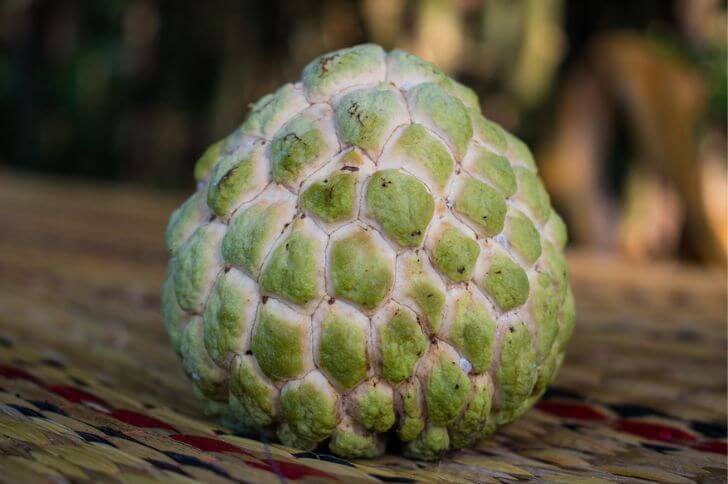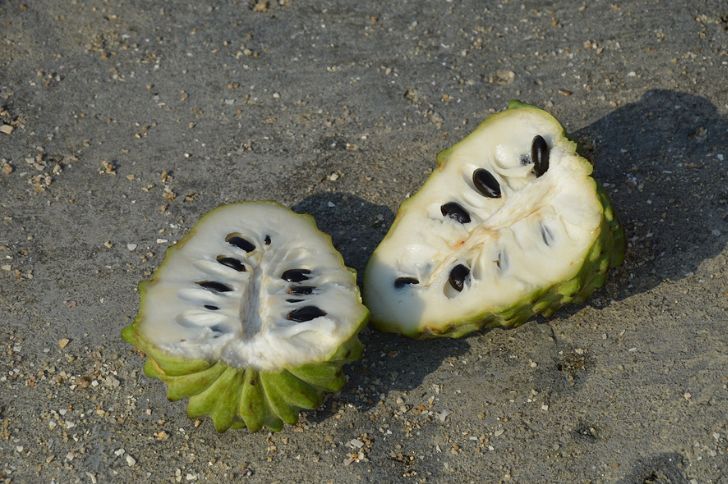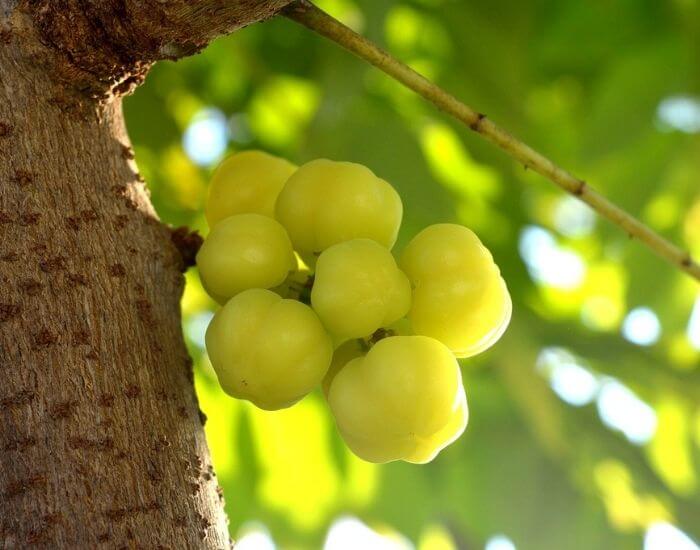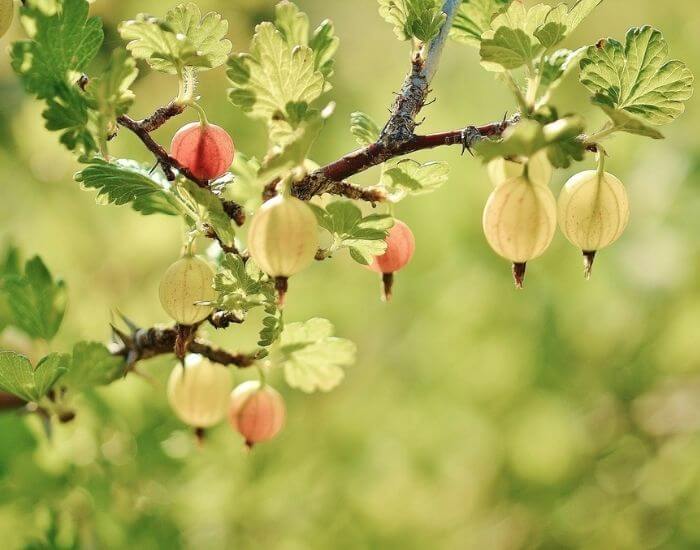Atis fruit, also known as sugar apple, is a tropical fruit that has been cherished for its deliciously sweet and creamy flesh. It is native to Central America and the Caribbean but can now be found in many parts of the world, including North America.
What is atis fruit?
It has a green, bumpy texture on the outside. Inside, it contains creamy white flesh with black seeds. The flesh of atis fruit is sweet and fragrant with a taste similar to custard.
Overall, atis fruit is not only a tasty treat but also offers numerous benefits making it an excellent addition to any diet or wellness routine.
Fruit color

Also known as sweetsop, it has a green exterior with soft bumps and the flesh inside is creamy white in color. However, the color of atis fruit can vary depending on its level of ripeness.
When unripe, it has a bright green color and feels hard to the touch. As it begins to ripen, the skin turns slightly yellowish-green with softer bumps and gives off a fragrant aroma.
When fully ripe, the atis fruit takes on a pale yellowish-green hue and becomes much softer to touch.
It’s important to note that while some may prefer their atis fruits when they are still bright green and hard, others wait for them to become fully ripe before consuming them as they are said to be sweeter when fully matured.
Regardless of personal taste preferences, knowing how to identify different stages of an atis’ color can help one choose fruits that suit their taste buds best.
How to tell if sugar apple is ripe
When it comes to determining if a sugar apple is ripe, there are a few things to look out for. Firstly, the color of the skin should be green or slightly yellow. If the skin is still very green, this means that the atis may not be fully ripe yet.
Another way to tell if an atis fruit is ripe is by pressing gently on the skin. If it gives slightly when pressed, then it’s ready to eat! However, be careful not to press too hard as this can damage the delicate flesh inside.
Finally, you can also check if an atis fruit is ripe by smelling it. A ripe atis will have a sweet and fragrant aroma that fills your senses when held close to your nose.
If you don’t detect any smell or if it smells sour or unpleasant, then it’s likely not ready yet and needs more time to ripen on the tree. By following these simple tips, you’ll be able to enjoy perfectly ripe and delicious atis fruits every time!
How to prepare atis fruit
To prepare sweetsop, first wash it thoroughly under running water to remove any dirt. Then, cut the fruit into halves and scoop out the white flesh using a spoon. Avoid eating the black seeds as they are not edible.
Atis fruit can be enjoyed in various ways, such as eating it fresh, blending it into a smoothie or juice, or adding it to salads or desserts. The sweet and fragrant flavor of atis pairs well with other tropical fruits like mangoes and pineapples.
Nutritional facts
1 Cup serving:
- Calories: 235 cal
- Fat: 0.7g
- Fiber: 11g
When is sweetsop in season
In general, atis fruit season varies depending on your location. In its native habitat of Central and South America, they are typically available from March through June. However, if you live in Southeast Asia or tropical regions, you may find this fruit available throughout the year because of their favorable climate conditions.
Related Read: Learn about Mamon Chino fruit
Sugar apple recipes
One popular way to enjoy it is by making smoothies or shakes with it. Simply blend chopped atis fruit with ice, milk and sweetener (optional) of your choice for a refreshing drink.
Atis fruit can also be used in baked goods such as cakes and pies. Its creamy texture adds moisture to these desserts while giving them a distinct flavor.
Moreover, atis fruit is often added to salads or served alongside other fruits like pineapple and mango. Its sweet taste pairs well with tangy fruits like citrus or sour apples.
Additionally, some people use it as a topping for yogurt bowls or oatmeal bowls for added nutrition and flavor. Overall, there are many ways to incorporate this delicious tropical fruit into your meals!
Also read: Types of Hairy Fruit
Taste
What does atis fruit taste like? It has a unique taste that can be described as sweet, slightly tangy, and creamy. The texture of the fruit is also quite interesting as it is soft and juicy with a grainy feel.
The flavor profile of atis fruit has been compared to a combination of flavors such as banana, pineapple, and strawberry. Some people describe it as having an almost custard-like consistency similar to an avocado or papaya. The aroma of the atis fruit is also quite distinct with hints of vanilla and citrus.
When eaten fresh, atis fruit can make for a delicious snack on its own or used in recipes such as smoothies or desserts. It can also be paired with other fruits such as mangoes or pineapples for added depth and complexity in flavor.
How to Eat

One way to eat atis fruit is by simply slicing it open and scooping out the flesh using a spoon. If you prefer chilled atis, store it in the refrigerator for a few hours before eating.
Another popular way to enjoy this green fruit is by making ice cream. Simply blend the pulp of the atis with cream, sugar, and vanilla extract until smooth; then freeze until firm.
In addition to these methods, it can also be used as a topping for pancakes or waffles for added sweetness and flavor.
Lastly, you can also make atis tea by boiling dried leaves of the tree in hot water for 10-15 minutes. Add lemon juice for flavor. Drinking atis tea regularly may help improve overall health in the long run.
How to store
When it comes to storing atis fruit, the key is to keep it fresh by preventing it from getting too ripe or too soft.
One way to store it is to wrap each piece in paper towels and place them in an airtight container in the fridge. This will help absorb any excess moisture and prevent the fruit from spoiling quickly.
Alternatively, you can also store this green fruit at room temperature for up to three days if they are not yet fully ripe.
Another important factor when storing atis fruit is avoiding exposure to direct sunlight or heat which can cause them to ripen faster than desired.
By keeping your atis fruits stored properly, you can ensure that they remain fresh and delicious for longer periods of time so that you can enjoy this tasty tropical treat whenever you want!
Where can you get atis fruit
If you’re looking to try sugar apples, you may be able to find them at your local Asian or Latin American grocery stores. Some specialty markets may also carry it during peak season which is typically from March through June.
Alternatively, if you live in a warmer climate, you may be able to find atis trees growing in your area. They are relatively easy to grow and maintain making them a popular backyard tree for many gardeners who enjoy its unique fruit.
In fact, some farmers markets may also sell fresh atis fruits directly from local growers during harvest season.
Is atis fruit same as soursop?
It belongs to the Annonaceae family, which includes other fruits such as cherimoya and soursop. While atis fruit and soursop share similar characteristics, they are not the same.
Atis fruit has a greenish-yellow skin with soft, white flesh inside that contains black seeds. Its flavor is described as sweet.
On the other hand, soursop has a prickly green skin with white flesh inside that also contains seeds but is more pulpy than atis fruit. Soursop’s flavor is often compared to a combination of pineapple and strawberry with sour notes.
In conclusion, although atis fruit and soursop may seem similar due to their appearance and taste profile, they are distinct fruits that offer unique nutritional benefits to those who consume them.
Source:
Hi There,
My name is Jenny. I’m the Chief Editor at Try Green Recipes and besides making yummy and healthy foods for my kids, grandkids, and friends. I’m new to the blogging world but I believe what I have to share is unique and will bring joy to your home. If you are adventurous and want try something tasty, let’s get started.

